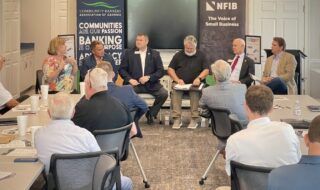February 1, 2022
Minnesota DFL Pushes Paid Leave Mandate
On January 31, the Minnesota Legislature convened for the 2022 Session (see Session Preview Part I, Part II). In the weeks leading up to session, Governor Walz and legislative leaders unveiled their plans for the session.
While the state budget was completed last year, a $7.7 billion surplus and $1.1 billion in unspent federal relief funds has set off a frenzy of tax cut and spending hike proposals.
The good news is Governor Walz and Senate Republicans agree on using surplus state or federal funds to repay the Unemployment Insurance program debt, which would reduce or erase the unemployment insurance tax increases set to take effect on small businesses. In fact, Governor Walz has proposed total repayment of the $2.7 billion debt and we are encouraging legislators to do the same.
There is also broad agreement on providing financial relief to farmers impacted by the drought last summer.
The bad news includes Governor Walz and Democratic legislators pushing for a 24 week Paid Family and Medical Leave mandate. In 2019 and 2021, a similar proposal passed the Democrat-controlled Minnesota House of Representatives but was blocked by Senate Republicans.
The mandate applies to small businesses and most other employers, and the only exemption is for employers who offer comparable paid leave on their own. The leave mandate includes up to 12 weeks for “the applicant’s serious health condition or pregnancy” and another 12 weeks for “bonding, safety leave, or family care.” There is an additional 12 weeks for “qualifying exigencies,” which is leave provided for the family of a military member called to active duty.
The first year of the program is paid for by a new .6 percent payroll tax on wages up to the FICA limit, which can be split between the employer and employee. In future years, the payroll tax can increase to any amount needed to cover the projected costs and reserve because there is no cap.
In the 2019 version of the proposal, the .6 percent payroll tax was projected to collect about $840 million in the program’s first year. The total program cost was estimated to be about $830 million, including all weekly benefit payments, operational costs and 300 new employees needed to run it. In reaching these figures, the state makes some key assumptions:
- 189,000 workers will use the leave program (out of 3.03 million total workers)
- the average worker will use 6.6 weeks of leave through the program
- the average weekly benefit payment is $598 (implying average annual income of $35,464)
If any of these assumptions is just a bit off – and there’s reason to doubt all of them – the program cost and the payroll tax could explode. Here are a couple of examples:
- Weekly Benefit Payment: the implied annual income used in the state assumption is below Minnesota’s median per capita income for the same year ($35,464 vs. $37,625) and well below the state’s median household income ($74,593). The average weekly benefit increases as average income increases, up to around $1,230 per week.
- Paid Weeks Taken: Advocates for a similar program in Connecticut that provides 12 weeks of paid leave in similar circumstances as this proposal assumed the average worker would take 7.2 weeks of leave. If adjusted for the 24 weeks allowed in the Minnesota proposal, the average would be 14.4 weeks taken.
The first chart shows the total program cost and real payroll tax rate for weekly benefits at the median per capita income:
Total Utilization by Employees at PCI | Costs | Real Tax Rate |
24 Weeks of Benefits at PCI | $15,009.31 | 24 Weeks |
Total Cost for Benefit Payments + Operations (24 Weeks) | $3,029,997,074 | 2.18% |
14.4 Weeks of Benefits at PCI | $9,005.59 | 14.4 Weeks |
Total Cost for Benefit Payments + Operations (14.4 Weeks) | $1,837,165,641 | 1.32% |
12 Weeks of Benefits at PCI | $7,504.66 | 12 Weeks |
Total Cost for Benefit Payments + Operations (12 Weeks) | $1,538,957,592 | 1.11% |
8 Weeks of Benefits at PCI | $5,003.10 | 8 Weeks |
Total Cost for Benefit Payments + Operations (8 Weeks) | $1,041,944,176 | 0.75% |
7.2 Weeks of Benefits at PCI | $4,502.79 | 7.2 Weeks |
Total Cost for Benefit Payments + Operations (7.2 Weeks) | $942,541,493 | 0.68% |
6.6 Weeks of Benefits at PCI | $4,127.56 | 6.6 Weeks |
Total Cost for Benefit Payments + Operations (6.6 Weeks) | $867,989,481 | 0.62% |
Program costs would increase rapidly with even a slight uptick in weekly benefit payments or average weeks taken.
The second chart shows the total program cost and real payroll tax rate at the state’s median household income (MHHI):
Total Utilization by Employees at MHHI | Costs | Real Tax Rate |
24 Weeks of Benefits at MHHI | $23,063.00 | 24 Weeks |
Total Cost for Benefit Payments + Operations (24 Weeks) | $4,630,120,311 | 3.33% |
14.4 Weeks of Benefits at PCI | $13,837.82 | 14.4 Weeks |
Total Cost for Benefit Payments + Operations (14.4 Weeks) | $2,797,243,893 | 2.01% |
12 Weeks of Benefits at MHHI | $11,531.52 | 12 Weeks |
Total Cost for Benefit Payments + Operations (12 Weeks) | $2,339,022,802 | 1.68% |
8 Weeks of Benefits at MHHI | $7,687.68 | 8 Weeks |
Total Cost for Benefit Payments + Operations (8 Weeks) | $1,575,320,983 | 1.13% |
7.2 Weeks of Benefits at PCI | $6,918.91 | 7.2 Weeks |
Total Cost for Benefit Payments + Operations (7.2 Weeks) | $1,422,580,619 | 1.02% |
6.6 Weeks of Benefits at MHHI | $6,342.33 | 6.6 Weeks |
Total Cost for Benefit Payments + Operations (6.6 Weeks) | $1,308,023,161 | 0.94% |
If the average income for program users is closer to median household income, program costs explode. Both employers and employees would face a significantly higher tax rate.
The program does include $5 million for small business assistance grants on a first come, first serve basis. An employer with fewer than 50 employees could receive up to $3,000 in wage replacement for family or medical leave and $1,000 for other wage-related costs.
NFIB strongly opposes this one-size-fits-all mandate. The math wouldn’t work in normal times, and a major payroll tax is the last thing small businesses right now.
See Gov. Walz’s full supplemental budget proposal here: 2022 Governor’s Supplemental Budget Recommendations with Descriptions (mn.gov).
See House Democrats’ session preview here: House DFL Press Conference 1/25/22 – YouTube
See Senate Republicans’ session preview here: Press Conference – Senate Republicans Announce 2022 Session Priorities – YouTube
NFIB is a member-driven organization advocating on behalf of small and independent businesses nationwide.
Related Articles














